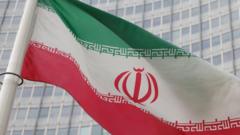The International Atomic Energy Agency has concluded that Iran has not fulfilled its nuclear non-proliferation commitments, raising international concerns.
Iran's Non-Proliferation Failures Highlight Tensions with Global Powers

Iran's Non-Proliferation Failures Highlight Tensions with Global Powers
Recent IAEA report indicates Iran's nuclear program non-compliance for the first time in two decades.
The International Atomic Energy Agency (IAEA) has reported that Iran is failing to meet its nuclear non-proliferation obligations, marking the first such finding in 20 years. This revelation comes as the IAEA's board of governors passed a resolution that signals the possibility of escalating the issue to the United Nations Security Council. The IAEA report highlighted Iran's general lack of cooperation, particularly regarding undisclosed nuclear activities and material in areas previously under scrutiny.
Iran’s Foreign Minister has cautioned European nations against supporting this resolution, labeling it a strategic misstep that would invoke strong Iranian responses. This development threatens to further complicate ongoing negotiations between Iran and the United States over a potential renewal of the nuclear agreement, which has been fraught with tension. The atmosphere is notably charged, especially after the U.S. advised its citizens to leave the Middle East amid reports of impending Israeli military actions targeting Iranian nuclear sites.
Iran maintains that its nuclear program is aimed solely at peaceful pursuits, vehemently rejecting any intentions to develop nuclear weapons. The 2015 nuclear agreement, made with six world powers, required Iran to limit its nuclear activities in exchange for relief from severe international sanctions. However, following the U.S. withdrawal from the agreement in 2018 under President Donald Trump—who criticized the deal for not adequately preventing nuclear weapon development—Iran has progressively violated the accord’s terms. This includes an increase in enriched uranium production, which has now reportedly surpassed 408 kg (900 lbs) at a purity level of 60%, just below weapons-grade levels and potentially sufficient to create up to nine nuclear bombs.
Iran’s Foreign Minister has cautioned European nations against supporting this resolution, labeling it a strategic misstep that would invoke strong Iranian responses. This development threatens to further complicate ongoing negotiations between Iran and the United States over a potential renewal of the nuclear agreement, which has been fraught with tension. The atmosphere is notably charged, especially after the U.S. advised its citizens to leave the Middle East amid reports of impending Israeli military actions targeting Iranian nuclear sites.
Iran maintains that its nuclear program is aimed solely at peaceful pursuits, vehemently rejecting any intentions to develop nuclear weapons. The 2015 nuclear agreement, made with six world powers, required Iran to limit its nuclear activities in exchange for relief from severe international sanctions. However, following the U.S. withdrawal from the agreement in 2018 under President Donald Trump—who criticized the deal for not adequately preventing nuclear weapon development—Iran has progressively violated the accord’s terms. This includes an increase in enriched uranium production, which has now reportedly surpassed 408 kg (900 lbs) at a purity level of 60%, just below weapons-grade levels and potentially sufficient to create up to nine nuclear bombs.

















